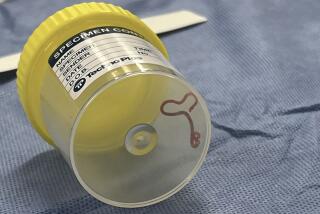Parasitic spiny-headed worm inspires super-strong skin-graft device
Scientists are harnessing the power of a parasitic worm to design a microneedle device that’s more than three times as powerful as conventional surgical staples -- without the risks and side effects.
The technology, described online Tuesday in the journal Nature Communications, could be used for delicate procedures such as skin grafts for burn victims and face transplants. They could even be used to deliver drugs into the body.
Current post-op techniques come with major drawbacks. Chemical adhesives can malfunction when blood is present. Sewing and stapling people back up is often painful, can introduce infection and sometimes causes a fair amount of damage – puncturing deep into tissue and damaging blood vessels.
And since staples are generally used just around the edges of a skin graft, the graft doesn’t always stay flush with the body as it stretches and bends, and can fail if fluid collects between the body and the graft.
Lead author Jeffrey Karp, a researcher at Brigham and Women’s Hospital, has a habit of looking to the natural world for adhesive ideas, such as gravity-defying gecko feet or grasping porcupine needles. Studying parasites for a solution to the issue was not much of a stretch.
“Parasites have all sorts of neat tricks that they use to latch onto and colonize hosts,” Karp said. “So we thought maybe if we looked into how parasites can colonize their hosts, we might be able to identify new mechanisms of adhesion.”
The researchers came across the parasite pomphorhynchus laevis, or the spiny-headed worm, which dwells in fish and attaches to hosts by sticking its proboscis into the intestinal wall and then inflating the appendage’s tip, mechanically locking it into place.
A device inspired by this remarkable ability would have to be stiff enough to penetrate tissue, but inflatable enough to fill open spaces.
To mimic the powerful proboscis, the researchers built a tiny array of cone-shaped microneedles with a stiff center made of some polystyrene and an outer layer with some polyacrylic acid mixed in (the same stuff that sucks up liquid in disposable baby diapers).
When a graft covered in the microneedles is inserted into the skin and makes contact with the water in natural tissues, the polyacrylic acid in the tips swells up, providing that mechanical lock with minimal pain and risk of infection.
The systems were 3.5 times stronger than surgical staples, and easy to remove – the needles deflate when they’re dried out.
“Currently we’re developing a degradable version of it,” Karp said. “We have a list of materials we’re exploring right now.”
Follow me on Twitter @aminawrite.






